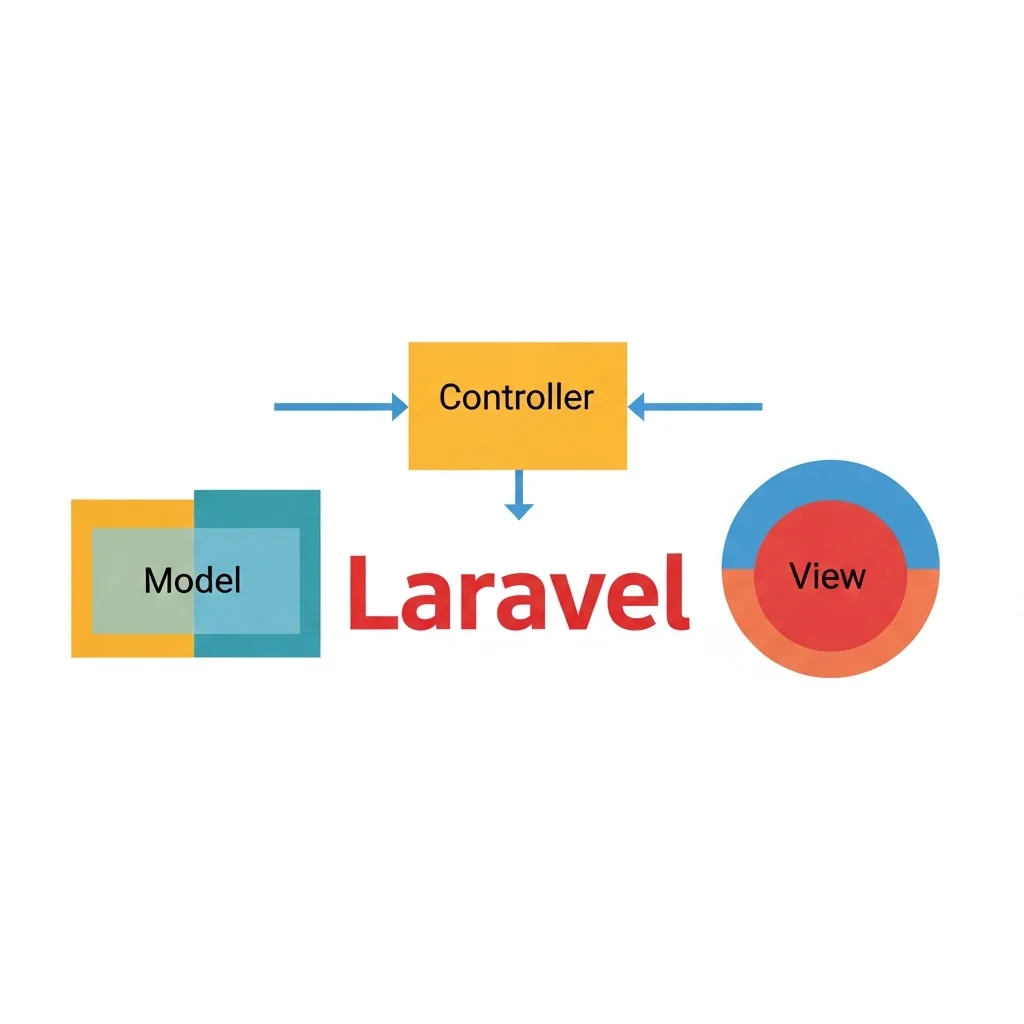Laravel framework and ecosystem
Overview
Laravel is an open-source web application framework written in PHP, designed to make building modern web applications easier. The framework primarily follows the Model-View-Controller pattern and ships with a large collection of built-in features for routing, authentication, caching, queueing and e-mail handling. In a relatively short time Laravel has become one of the most widely used PHP frameworks and sits at the heart of an extensive ecosystem of official and community packages, tooling and services.
The Laravel ecosystem includes official infrastructure products for hosting and monitoring, starter kits for front-end integration, a broad collection of first-party packages for common application features, and an active community offering documentation, training and conferences. This combination makes Laravel attractive for both small and large software projects, ranging from simple websites to scalable SaaS platforms.
History and development
Laravel was first introduced in the early 2010s with the aim of providing a modern, elegant successor to existing PHP frameworks. The initial versions focused mainly on core functionality such as routing, controllers and simple authentication. As the framework matured, extensive features were added for database abstraction, migrations, command-line tooling and comprehensive test support.
Laravel follows an iterative release cycle. Major versions typically deliver improvements in performance, type safety, syntactic refinements and support for new PHP versions. Minor releases add incremental improvements and new helpers. In recent years a lot of attention has been paid to performance optimisations for large applications, improved queue and job handling, and extensibility through events and contracts, ensuring the framework remains suitable for complex, business-critical systems.
Laravel is developed as open source, with the core maintained by a dedicated team and many external contributors. The project is hosted on GitHub and makes use of modern development practices such as automated tests, continuous integration and a clear release policy. Around the framework a commercial ecosystem has arisen with training, conferences and paid products, which in turn contribute to the further development of the ecosystem.
Architecture and core concepts
MVC and application structure
The Model-View-Controller pattern forms the basis of most Laravel applications. Models represent the data and business logic, views handle presentation, and controllers coordinate the interaction between the two. Laravel provides a standard directory structure that clearly separates these roles, including folders for controllers, models, views, configuration, tests and resources.
Additional layers such as service classes, repositories and actions can be added within this structure, yet the framework itself does not prescribe a specific domain architecture. Development teams can therefore apply architecture styles such as Domain-Driven Design, hexagonal architecture or a more traditional MVC approach without running into framework limitations.

Routing and controllers
The routing layer in Laravel maps incoming HTTP requests to closures or controller actions. Routes can be grouped, assigned middleware, named, and given parameter constraints. Laravel supports resource routes for standard CRUD patterns and provides facilities for nested routes, sub-domains and API-specific routes.
Controllers are classes that define individual actions as methods. Laravel supports both traditional controllers and single-action controllers. Dependency injection is available out of the box, allowing services and repositories to be injected via type hints in controller constructors or methods. This promotes testability and loose coupling.
Blade templating engine
For the presentation layer Laravel offers Blade, a lightweight templating engine that extends PHP with expressive syntax for control flow, components and layout inheritance. Blade templates are compiled to PHP and then cached to optimise performance.
Blade supports components and slots, enabling reusable interface elements such as navigation, forms and modals to be built consistently. It also integrates directly with route helpers, translation functions, security filters and conditional display based on authorisation.
Eloquent ORM and database layer
Eloquent is the object-relational mapper in Laravel and provides an Active Record-like approach to database interaction. Each model usually corresponds to a database table and offers methods to retrieve, create, update and delete records. Relationships between tables, such as one-to-many, many-to-many and polymorphic relations, are defined via declarative methods on models.
Besides the ORM, Laravel provides a query builder for more complex queries, database migrations for schema management, seeding for test data and support for multiple database connections. Transactions, soft deletes and eager loading are built-in features that simplify and optimise working with relational databases.

Command-line interface and Artisan
Artisan is the command-line interface provided by Laravel and is a key part of the developer experience. Through Artisan developers can generate new classes, run migrations, process queues, execute scheduled jobs, clear caches and perform many other management and development tasks.
The CLI is extensible with custom commands that use the same infrastructure, including dependency injection. This makes it possible to integrate background tasks, import scripts and maintenance processes into the application in a consistent way.

Key framework features
Authentication and authorisation
Authentication is included in Laravel by default via guard and provider configuration. The framework offers ready-made flows for registration, login, password reset, e-mail verification and profile management, which are further simplified through starter kits. Authentication can be handled via sessions, tokens or API-specific mechanisms.
Authorisation is supported through policies and gates. Gates allow simple, global permission checks, while policies link authorisation rules to specific models, enabling fine-grained access to resources. These mechanisms can be applied in controllers, routes, Blade views and even within Eloquent queries.
Validation, forms and error handling
Laravel provides an extensive validation layer for incoming data. Rules can be defined inline in controllers or via dedicated Form Request classes, which combine both validation and authorisation. Common validation rules are already present, while custom rules can be added as separate classes or closures.
For error handling Laravel uses a centralised exception handler in which both logging and the display of errors can be configured. In development mode detailed error pages are shown, whereas in production environments generic error messages and structured logging are used.
Queueing, jobs and task scheduling
For background processing Laravel offers a queue system that supports various queue back-ends such as relational databases, Redis and external queue services. Tasks are defined as job classes and executed asynchronously by queue workers. The framework supports retries, back-off strategies, job batching and chained jobs.
Alongside queues, Laravel includes a built-in task scheduler that leverages server-level cron and a declarative schedule defined in code. This allows recurring tasks such as report generation, clean-up scripts and synchronisation processes to be configured and managed with ease.
Caching and performance optimisations
Laravel contains a unified cache abstraction that can address various back-ends such as file, database, Redis and Memcached. Many parts of the framework, including routing, configuration and views, can be compiled and cached to boost performance. Recent versions of Laravel have added further optimised cache strategies and lazy-loading improvements to minimise overhead for high-traffic applications.
Laravel ecosystem
Core packages
Laravel maintains a range of official packages that integrate seamlessly with the framework.
Scout provides full-text search integration for Eloquent models, with support for various search back-ends.
Cashier handles subscriptions and payments for services such as Stripe and other payment providers.
Socialite simplifies social login via providers such as Google, Facebook and other OAuth vendors.
Sanctum delivers simple token-based authentication for single-page applications and APIs.
Horizon offers a graphical interface and monitoring for Redis-based queues.
Dusk provides browser-based end-to-end tests with a straightforward API.
Telescope is a debugging and inspection tool that gives insight into requests, queries, logs and other internal events.
Sail supplies a Docker-based development environment for Laravel projects.
Pint is an opinionated code-style tool that automatically formats code.
These packages are designed according to the same principles as the framework itself and use the underlying service container and configuration infrastructure.
Starter kits and front-end integration
Laravel offers multiple starter kits that simplify setting up a new application with modern front-end technology. These kits provide a working foundation with authentication, default pages and an integrated build pipeline for assets.
React starter kit for applications based on Laravel, Inertia and React.
Vue starter kit for applications based on Laravel, Inertia and Vue.
Livewire starter kit for full-stack applications where components are driven by PHP and updated through small HTTP requests.
These starter kits include routes, controllers, views and example implementations of features such as login, registration, profile management, password reset and a dashboard, complete with light and dark mode support.
Infrastructure and cloud products
The Laravel ecosystem contains several infrastructure products that make deploying and managing applications easier.
Laravel Cloud is a fully managed platform for deploying and hosting PHP applications. It offers automatic scaling, integration with queues and support for modern deployment workflows.
Forge is a server management tool that enables developers to configure and manage their own VPS or cloud servers and deploy Laravel or other PHP applications to them.
Nova is an admin panel solution that allows management screens for existing applications to be built, including resource views, filters, actions and metrics.
Nightwatch is a monitoring and observability platform that provides insight into performance, logging and application health within the Laravel landscape.
Reverb is a service for scalable WebSocket communication, enabling real-time functionality such as notifications, chat and live dashboards.
These products are optional but fit seamlessly with the conventions and tooling of the core framework.
Community and documentation
The Laravel community plays a crucial role in the adoption and ongoing development of the framework. There are official documentation pages that systematically describe every part of the framework, including guides, API references and upgrade manuals. In addition, there are training platforms, screencast series and an official bootcamp that explains the fundamentals of Laravel.
Conferences such as Laracon and its regional variants are physical meet-ups where new features are announced, best practices are shared and case studies are presented. Online forums, chat groups and Q&A platforms facilitate daily knowledge exchange between developers of all levels.
Composer and Packagist host thousands of community packages that target Laravel, ranging from small helpers to complete modules for content management, e-commerce and integrations with external APIs. This open-source culture makes it possible to reuse functionality and contribute improvements for the benefit of the entire community.
Use cases and application areas
Laravel is used for a wide variety of web-based solutions. Common scenarios include:
SaaS platforms where user registration, subscriptions, roles and extensive business logic are central.
Internal company portals, dashboards and administrative systems that require a robust data and authorisation layer.
API back-ends that power mobile apps, single-page applications or microservices.
Content-rich websites and blogs, often in combination with headless or traditional templating approaches.
Integration platforms that collect and transform data from multiple sources.
Thanks to the combination of MVC structure, extensive ORM, queueing, caching and a large ecosystem of packages, Laravel is particularly suitable for projects where both development speed and maintainability are important.
Relationship with modern PHP and future developments
Laravel closely follows developments within PHP. New versions of the framework typically make use of recent language features such as type hints, union types, attributes and the performance improvements offered by new PHP releases. The focus lies on striking a balance between modern language constructs and practical applicability for a broad audience.
In recent years attention within the framework and ecosystem has shifted towards even better scalability, observability, developer experience and integration with modern front-end and infrastructure concepts. Examples include improved first-party support for real-time functionality, streamlined deployment pipelines and tooling tailored to containerised environments and distributed systems.
Laravel is expected to continue evolving as an opinionated yet flexible framework that meets the demands of modern web development. The combination of a stable core, a rich ecosystem and an active community forms the foundation for this.
